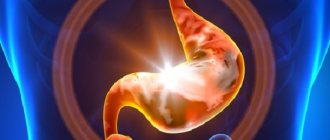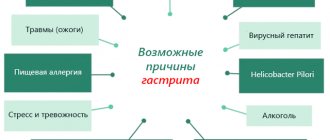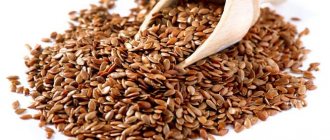Gastritis or functional dyspepsia?
The term “gastritis” is usually used to refer to various inflammatory and degenerative changes in the gastric mucosa. But in fact, the disease itself is quite rare and can only be diagnosed using a biopsy during a gastroscopy procedure.
Often what is called gastritis is functional dyspepsia (a set of disorders of the digestive system). The term “gastritis” is also mistakenly used to mean gastroesophageal reflux disease (GERD) or irritable bowel syndrome (IBS).
Currently, the diagnosis of “gastritis” is usually made in the presence of morphological signs discovered after undergoing a series of medical examinations, in particular, after laboratory identification of the main causative agent of the disease - the bacterium Helicobacter pylori (H. Pilory), histological studies and FGDS.
Is it possible to do without medications?
It is possible to help the body cope with a high temperature without the use of antipyretic medications.
- First of all, you need to ventilate the room. The room temperature should not exceed 23 ˚C with a humidity of 40-60%.
- Rubbing with water at room temperature helps a lot , but not with ice or alcohol. They cause spasm of peripheral vessels and reduce heat transfer.
- Follow your diet. Fever develops with acute gastritis or exacerbation of chronic gastritis. In such cases, complete fasting is recommended on the first day. In the future - the most gentle diet.
- Drink more. You are allowed to drink mineral water without gas, with a moderate exacerbation - warm milk with honey, rosehip decoction, with hypoacid gastritis - cranberry juice.
An increase in temperature is an important symptom that you should definitely pay attention to. Even low fever with gastritis is a sign of a severe course of the disease. Therefore, despite the fact that you managed to cope with the temperature in just a couple of days, it is still advisable to visit a doctor.
There may be a need to undergo a comprehensive examination and correct treatment. If the fever reaches high levels and persists for a week, then a visit to the doctor becomes mandatory. The sooner you seek medical help, the lower the risk of complications.
Signs and symptoms of gastritis
It should be noted that the first signs and symptoms of gastritis are indeed very similar to the sensations of patients with functional dyspepsia or GERD.
The patient’s well-being worsens, symptoms such as heaviness, bloating, discomfort in the upper abdomen, and cutting pain appear (usually after eating). Loss of appetite, nausea, vomiting, and stomach bleeding may occur.
Functional dyspepsia is characterized by a wider range of symptoms, from pain and heaviness in the abdomen to nausea and belching. However, these clinical signs are not the result of inflammatory processes; patient complaints indicate individual digestive problems, which are corrected by a gastroenterologist.
With gastritis, morphological changes in the gastric mucosa are observed. To identify them, it is necessary to undergo video gastroscopy and a thorough laboratory examination.
Diagnostics
The question of how to treat gastritis is relevant for many people faced with this problem. First of all, it is necessary to undergo a comprehensive diagnosis. Its purpose is to determine the specifics of the disease in a particular case. As part of the diagnosis, the doctor interviews the patient and examines him. During the dialogue, the doctor asks the patient what he ate before symptoms appeared, what medications he uses, and whether he has any concomitant diseases. Among the signs indicating the presence of acute gastritis in a patient are problems with the skin, plaque on the tongue, rashes between the nose and lips, and an unpleasant odor from the mouth. When palpating the abdomen, pain occurs.
To confirm or refute the diagnosis, the gastroenterologist must conduct a comprehensive study, the results of which allow one to obtain an accurate answer to the question of what the patient is sick with.
Causes of gastritis
The main causes of gastritis are associated with the activation of aggressive processes in the body, which lead to a change in the acid-base environment in the stomach and the destruction of the protective epithelial layer of the stomach walls, which causes tissue inflammation.
Provoking factors for inflammatory and dystrophic changes in the gastric mucosa are stress, malnutrition, taking non-steroidal drugs (aspirin, analgin, diclofenac, ibuprofen) and the bacterium Helicobacter Pilory. The last factor is the most common cause of such diseases. “Helicobacter pylori” supports the inflammatory process in the stomach. A person can become infected with this bacterium in childhood and throughout his life. It multiplies in the body and gradually colonizes the mucous membrane. This process can take decades. If the bacteria is aggressive, it will eventually cause an inflammatory process.
Fever in chronic gastritis
Exacerbation of chronic gastritis can also provoke a rise in temperature. However, the characteristics of fever depend on the form of the disease.
With hypoacid or atrophic gastritis , fever is usually associated with eating foods that are too fatty and difficult to digest. With insufficient production of enzymes and hydrochloric acid, food cannot be processed completely, the processes of rotting and fermentation begin, and pathogenic bacteria multiply in it.
The disturbances are aggravated by the fact that the disinfecting function of the stomach in conditions of hydrochloric acid deficiency also does not work. The temperature with reduced secretion usually increases slowly, up to 37-38 ˚C.
Hyperacid gastritis can also cause fever. In this case, it develops in response to an active inflammatory process and the death of epithelial cells under the influence of hydrochloric acid. In such a situation, the temperature rarely rises above 37.5˚C.
A temperature reaction against the background of erosive gastritis always makes you wary, since it can be a symptom of internal bleeding or the degeneration of erosion into a gastric ulcer. The main sign of gastric bleeding is a change in stool. Due to the admixture of digested blood, it becomes black and tarry.
Important information. You need to pay attention to the type of temperature increase. With chronic gastritis, there is usually a constant or relieving fever, in which daily temperature fluctuations do not exceed 1 ˚C. Other options with pronounced temperature changes during the day may be a sign of a life-threatening condition.
Forms and stages of gastritis
Inflammatory processes in the mucous tissues of the stomach develop gradually. In the initial stages, gastritis can be practically asymptomatic. But sooner or later the disease makes itself felt and becomes acute.
Acute gastritis is characterized by a sharp deterioration in health, the appearance of acute pain and heaviness in the stomach. Often, an exacerbation can be triggered by some irritant, for example, after taking medications, spicy food, alcohol, etc.
If acute gastritis is not treated in time, the disease may progress to the next stage. Chronic gastritis develops in 85% of cases. Periods of remission are followed by exacerbations of the disease, which in the future can lead to such serious consequences as gastric ulcers or even oncology.
Why you shouldn’t lower the temperature
Fever is considered a protective reaction to inflammation and the penetration of a foreign object into the body. According to medical literature, against the background of rising temperatures, antibodies to microbes are more actively produced, the concentration of protective cells in the blood - leukocytes - increases, vital processes and the rate of reproduction of many bacteria slow down.
That is why you should not reduce low-grade fever, as you will only complicate the body’s process of fighting infection and inflammation.
All the negative consequences of high temperature appear only when the threshold is reached at 39 ˚C or prolonged low-grade fever.
Particular care should be taken in lowering the temperature in children. Due to imperfect thermoregulation mechanisms, their fever always reaches higher numbers. Even a temperature of 39˚C is not considered critical for children.
Dr. E. O. Komarovsky talks in detail about how to properly assist children with fever in this video:
Treatment of gastritis
Treatment includes relief of exacerbation and prevention of relapse; it can last from ten days to several months. The duration of treatment depends on the degree of damage to the gastric mucosa. The doctor prescribes medications individually for each patient. Ignoring the symptoms of gastritis is dangerous. If you do not see a doctor in time and start treatment, it can cause serious complications. In some cases, this leads to esophageal cancer, gastric bleeding, and ulcers.
Drugs for the treatment of gastritis
If Helicobacter is detected, patients are prescribed antibiotics and drugs to create unfavorable conditions for the life of bacteria; in case of increased acidity and gastropathy, inhibitors are prescribed.
Gastritis with low acidity
Depending on the secretory activity of the stomach, two forms of the disease are distinguished - with high acidity and with low acidity. The latter is characterized by the following symptoms: unpleasant taste in the mouth, loss of appetite, rumbling in the stomach, nausea. However, only a doctor can accurately determine the course of the disease based on tests.
Exacerbation of gastritis
In the chronic course of the disease, periods of remission alternate with periods of exacerbation. Therapy will differ at different times. If symptoms are severe, exacerbation is treated in a hospital. During an exacerbation, it is also important to follow the diet especially carefully. You need to eat only healthy foods and 4-6 times a day in small portions.
How to lower the temperature with gastritis
The main problem with elevated temperatures due to gastritis is the inability to take conventional antipyretic and anti-inflammatory drugs. This is due to their negative effect on the mucous membrane of the digestive tract. Non-steroidal anti-inflammatory drugs will only increase inflammation and pain.
The most correct solution would be to take medications that protect the gastric mucosa (Losec, Omez, Nexium, Almagel, Gaviscon) for hyperacid gastritis or enzyme agents (Festal, Mezim, Creon) for hypoacid gastritis.
If the temperature is below 38 ˚C and is not accompanied by general malaise, joint and muscle pain, or headache, then there is no need to use antipyretics. If the temperature reaction is higher and the patient’s general condition suffers significantly against its background, then it is permissible to take a Paracetamol tablet after one of the gastric secretion blockers - Omez, Nexium, Losek.
Prevention of gastritis
To prevent gastritis, you should adhere to a healthy lifestyle: stop smoking, do not abuse alcohol, avoid stress and engage in any type of physical activity. It is especially important to monitor your diet. It must be complete and balanced. Try to include less junk food in your diet, do not skip meals, make sure that your body fully receives the necessary substances: proteins, fats, carbohydrates, minerals, micro- and macroelements, vitamins.
You can make an appointment with a gastroenterologist at the Naedine Clinic by phone in Kirov: (8332) 32-7777 or through the form on the website
Three-step algorithm for treating abdominal pain
Why painkillers don't help
Let's start with the simplest question: what should you do if discomfort appears in the abdominal area?
Of course, take a pill! For many of us, the answer is... "obvious." A person who cares “too much” about health, much less knows “more than necessary” about it, looks strange. From the point of view of many around him, he simply has nothing to do! The results are obvious: 45% of Russians, feeling pain in the stomach, grab analgesics... And only 28% take antispasmodics. Moreover, over the past six months, every sixth person felt pain in the abdominal area. Women are more often affected. Why is an analgesic dangerous for abdominal pain?
Because it will not eliminate the true cause of the unpleasant sensations, but will disguise it. Indeed, in 60% of cases the culprit of the pain syndrome is spasm.
What is a spasm?
This is an excessive contraction of smooth muscle cells in various organs. In our case we will talk about the digestive system. Inflammatory process - for example, gastritis, enteritis, colitis or ulcers, poisoning and other exposure to pathogenic microbes, a foreign body in the cavity of the digestive organ (a part from a toy in the stomach or a stone in the gall bladder), an imbalance of the substances we need - vitamins and microelements... Because of this, our organs, which are one way or another responsible for digesting food, feel uncomfortable and painfully contract. Analgesics do not act on the cause of the pain, and they will only affect the transmission of nerve impulses, and will not remove the spasm. Plus, as was said earlier, they will mask the pain - and the doctor will not understand anything. Or he will understand, but it’s too late. After all, the remaining 40% of abdominal pain - 4 cases out of 10 - are conditions in which you need to call an ambulance!
Acute pancreatitis, appendicitis, perforation of an ulcer, rupture of an aneurysm of blood vessels in the abdominal cavity, severe inflammatory diseases in women. Peritonitis is an inflammation of the peritoneum, which occurs not only when the appendix ruptures, but also when “treating” gynecological diseases through patience. A stone that has passed out of the gallbladder and blocked the bile duct. If you take an analgesic, it will be difficult for the doctor to understand where the cause of the illness is. And precious time when emergency surgery should have begun will be lost. The antispasmodic will not affect the sensations caused by acute cholecystitis, perforation of an ulcer or rupture of the appendix. The pain will not decrease.
What happens if you “treat” ordinary chronic gastritis with an analgesic?
Painkillers of this type are harmful to the gastric mucosa (and other digestive organs). If you take non-steroidal anti-inflammatory drugs for just a week, then one in five will have a stomach ulcer. And one in seventy will experience gastrointestinal bleeding. What if such patients also take analgesics to relieve pain? “Harmless and safe” drugs for pain relief have their side effects. Therefore, non-steroidal anti-inflammatory drugs and other analgesics should be taken under the supervision of a doctor! Turning them into daily medicine is dangerous. By the way, how long can you “treat yourself” with painkillers?
What to do if your stomach hurts?
In 2002, Vladimir Trofimovich Ivashkin, academician of the Russian Academy of Medical Sciences, chief gastroenterologist of Russia, director of the Clinic of Propaedeutics of Internal Diseases, Gastroenterology, Hepatology of the First Moscow State Medical University named after. THEM. Sechenov, developed a stepwise algorithm of actions for abdominal pain:
• Stage one – mild pain What to do: if necessary, take an antispasmodic. But: – if the pain occurred once, after unusual or poor-quality food, eating disorders or overeating, this is one situation. And if pain occurs with sufficient frequency, i.e. the stomach hurts sometimes or periodically, or in the morning, or after nervous stress, or even from hunger - the situation is completely different. Go to the doctor for an appointment as soon as possible!
• Stage two – the pain is quite severe and/or long-lasting. What to do: be sure to take an antispasmodic. After this, even if your stomach hurts less or the abdominal pain stops altogether, consult a doctor immediately!
• Stage three – very severe pain! Or pain that gets worse. If your stomach hurts unbearably, the cause could be those same 40% - appendicitis, rupture of the gallbladder, perforation of an ulcer, thrombosis of intestinal vessels. What to do: call an ambulance!
Five principles that are important for everyone to know
Abdominal pain is a special pain. Its nature is simply not taken into account by universal drugs for pain relief. And our compatriots, having encountered at least once a modern “optimized” clinic (according to Ministry of Health standards, there is one gastroenterologist per 70 thousand people), try to solve the problem by taking a pill. They will not be told why this is dangerous. After all, there are not enough doctors even for treatment, let alone for prevention and health schools. Therefore, the French manufacturer SANOFI organized a training program - “Pain that is dangerous to anesthetize” with the involvement of gastroenterologists in the educational project. Clinical pharmacologist, candidate of medical sciences, Alexander Maslyakov has developed another instruction for the patient - five principles of action for abdominal pain.
• Principle 1. One of the causes of abdominal pain is spasm, a contraction of the smooth muscles of the digestive organs under the influence of unfavorable factors. For this reason, medications that relieve pain are only first aid. Be sure to find out why your stomach hurts, i.e. what is the condition of the gastrointestinal tract, liver, gallbladder, pancreas and spleen.
• Principle 2. The first choice drug for abdominal pain is an antispasmodic. If you have a spasm of the smooth muscles of the stomach or intestines, you will feel less pain after taking the medicine. And in acute conditions that require urgent surgery, antispasmodics will not mask the pain, and the doctor will have time to understand what happened and how to act.
• Principle 3. For abdominal pain, analgesics are dangerous! They must not be used under any circumstances! A drug of this type will not eliminate the cause of pain - it will simply block the transmission of signals about problems in the body. The brain does not know about problems. Doctors won’t even know about them - after all, the pain sensations are masked, and it’s difficult to make a correct diagnosis.
• Principle 4. If an antispasmodic does not relieve pain within 2–3 hours, consult a doctor!
• Principle 5. If the abdominal pain is severe, if it increases or even simply does not decrease, if you have a high temperature, if your blood pressure is low, if you have nausea and/or vomiting, if you have a headache, call an ambulance immediately!
Be careful! Take care of yourself!
Link to publication: life24.ru
The main diseases manifested by low-grade fever:
- Chronic infectious diseases (chronic tuberculosis, brucellosis, sinusitis, pyelonephritis, parasitic lesions, cytomegalovirus, herpes, mononucleosis, sexually transmitted diseases and many other focal infections in a chronic form);
- Diseases associated with impaired immune response (rheumatism, rheumatoid arthritis, vasculitis, post-infarction syndrome). This group also includes diseases of an allergic nature;
- Malignant neoplasms (leukemia, lymphoma, hepatoma, kidney adenocarcinoma, etc.);
- Diseases of the endocrine system ( pathological menopause, thyrotoxicosis, pheochromocytoma, etc.);
- Diseases of the central nervous system of various etiologies ( traumatic brain injuries, neuroinfections, etc.).
Low-grade fever in children, especially young children, often has no connection with any pathology. It occurs due to the body’s thermoregulation not yet established. Children's body temperature rises after physical activity, overheating, and in infants after eating.
One of the common causes of persistent low-grade fever is psychological and mental stress, as well as stress, accompanied by general poor health, dizziness, and shortness of breath.











